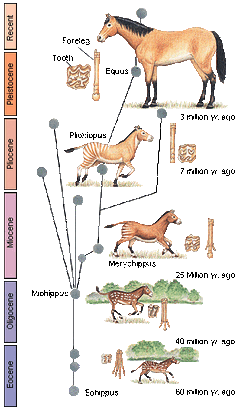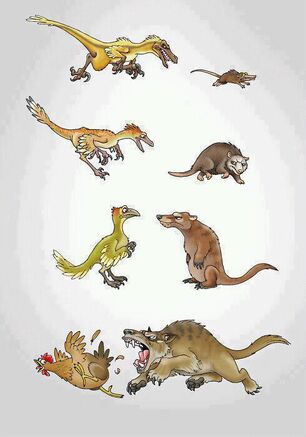Cope's Rule
The evolutionary trend toward a larger body size overtime, which is seen in both carnivore and herbivore species (Van Valkenburgh et al., 2004).

The evolution of the horse following Cope's Rule
This theory was named after Edward Cope (1840-1897), paleontologist, who used a phylogenic system to explain body size trends in dinosaurs (www.sciencedaily.com, 2012). He believed that parts of the body would become more developed if used the most, even at the expense of other parts. His theories stated that diversity and divergence were created through the changes of developmental timing. He also believed that species which shared developmental patterns could be grouped into more specific groups, such as families, genera, etc (www.ucmp.berkeley.edu).
Pros vs Cons[]
Benefits[]
- Increased predation success
- Increased defense against predators
- Enhance reproductive success
- Improve thermal efficiency
- Greater range of food choices
- Increased inter-species competition success
- Extended life span
(Hone & Benton, 2005; Van Valkenburgh et al., 2004; www.wisegeek.com, 2013)
Problems[]
- Increase in developmental time
- Require more food and water
- Susceptible to extinction; reduces ability to adapt to sudden changes
- Produce fewer offspring
(Hone & Benton, 2005)
Examples[]
Many dinosaurs followed this trend, such as ceratopsids and hadrosaurs which increased in size before gradually decreasing again. Theropods like Tyrannosaurus rex showed an upper limit on the range of body size as well. However, other dinosaurs such as four-legged sauropods (ie: brachiosaurus) and ornithopods (ie: iguanodons) did not show the uppermost limits in size despite containing some of the largest land species ever to exist (www.sciencedaily.com, 2012).
The most prominent examples can be seen through the evolution of land mammals in North America during the mid-late Pleistocene. Carnivores such as dire wolves increased in size in order to take down the larger prey (Van Valkenburgh et al., 2004)

Cartoon rendition of carnivore evolution based on Cope's Rule
References[]
Hone, D. & Benton, M.(2005). The evolution of large size: how does Cope’s Rule work?. TRENDS in Ecology and Evolution. 20(1): 4-6
www.sciencedaily.com.(2012). Were Dinosaurs Destined to Be Big? Testing Cope’s Rule.www.sciencedaily.com/releases/2012/11/121102151954.htm
http://www.ucmp.berkeley.edu. Edward Drinker Cope (1840-1897). http://www.ucmp.berkeley.edu/history/cope.html
Van Valkenburgh, B., Wang, X. & Damuth, J.(2004). Cope’s rule, hypercarnivory, and extinction in North American canids. Science, 306: 101-104
www.wisegeek.com. (2013). What is Cope’s Rule?. www.wisegeek.com/what-is-copes-rule.htm